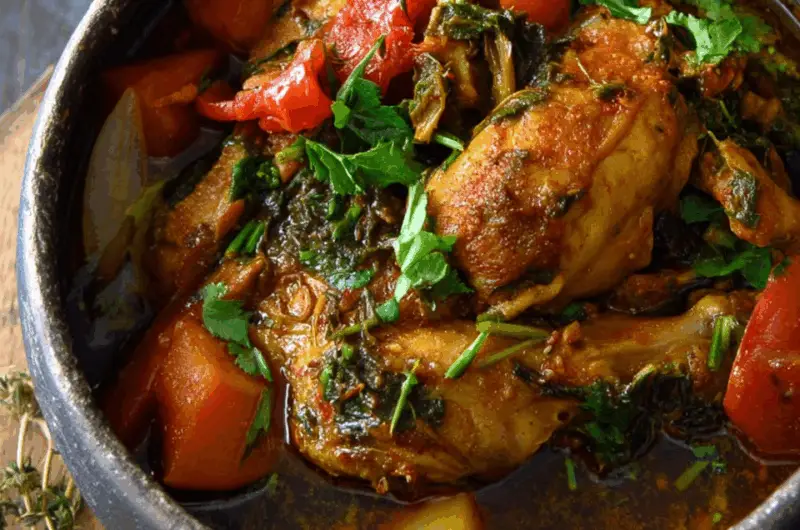The comforting flavors of Ecuadorian cuisine come alive in this hearty chicken stew. With tender pieces of chicken simmered in a vibrant broth infused with garlic, tomatoes, and achiote, each bite is bursting with warmth and spice. Potatoes soak up the flavorful juices, making every spoonful satisfyingly rich and delicious. This dish is a reflection of Ecuador’s love for soul-satisfying home cooking. It’s simple, nourishing, and deeply aromatic perfect for family meals or impressing guests with something new and traditional. Pair it with rice or warm bread for a complete, authentic experience that will transport you straight to the heart of the Andes.
Full Recipe:
Ingredients:
-
2 lbs chicken thighs (bone-in, skin removed)
-
2 tablespoons olive oil
-
1 large onion, chopped
-
4 cloves garlic, minced
-
1 bell pepper, sliced
-
2 medium tomatoes, diced
-
2 tablespoons ground annatto (achiote powder)
-
1 teaspoon cumin
-
1/2 teaspoon oregano
-
4 medium potatoes, peeled and chopped
-
1 cup chicken broth
-
1/2 cup water
-
Salt and black pepper to taste
-
1/4 cup chopped cilantro
-
Lime wedges for serving
Directions:
-
Heat olive oil in a large pot over medium heat. Add chicken and brown on both sides, about 5 minutes per side. Remove and set aside.
-
In the same pot, sauté onions, garlic, and bell pepper until softened, about 5 minutes.
-
Add tomatoes, annatto, cumin, and oregano. Cook for 3-4 minutes until the tomatoes break down.
-
Return the chicken to the pot and stir to coat with the aromatics.
-
Add potatoes, chicken broth, and water. Season with salt and pepper.
-
Cover and simmer over medium-low heat for 35–40 minutes, or until the chicken is tender and the potatoes are cooked through.
-
Sprinkle with fresh cilantro before serving. Serve with lime wedges and white rice if desired.
Prep Time: 15 minutes | Cooking Time: 45 minutes | Total Time: 1 hour
Kcal: 380 kcal | Servings: 6 servings
Discover the Flavors of Ecuador: A Deep Dive into Ecuadorian Chicken Stew
Ecuadorian cuisine is a beautiful blend of indigenous flavors, Spanish colonial influence, and the rich biodiversity of the Andean region. One dish that perfectly represents this harmony is Ecuadorian Chicken Stew, or as it’s often referred to locally, “Seco de Pollo.” This traditional meal is more than just a stew; it’s a cultural experience simmered in spices, regional produce, and deep-rooted culinary techniques passed down through generations.
Whether you’re a fan of global cuisine or just looking for something new to spice up your dinner table, Ecuadorian Chicken Stew is a flavorful, satisfying choice that brings comfort and character to every bite. In this article, we’ll explore the background, regional variations, flavor profiles, health benefits, and serving suggestions for this iconic Ecuadorian dish.
A Rich History in a Bowl
Stews are a staple of many cultures, but in Ecuador, the preparation of seco dishes goes far beyond simple meat and potatoes. Ecuadorian Chicken Stew has indigenous roots, with methods of slow cooking and using local herbs and spices long predating colonial influence. Over time, Spanish colonizers introduced new ingredients like onions, garlic, and cumin today essential components of this beloved meal.
Traditionally prepared for family gatherings or festive events, Seco de Pollo is a dish that speaks of hospitality and shared heritage. It’s a reflection of the Ecuadorian lifestyle practical, communal, and always centered around good food.
Flavor Profile: Earthy, Bold, and Comforting
One of the defining features of Ecuadorian Chicken Stew is its robust and earthy flavor. The key ingredient that sets it apart from other stews around the world is achiote, or annatto powder. Achiote gives the stew a beautiful golden hue and a slightly nutty, peppery flavor that blends wonderfully with the garlic, cumin, and oregano typically used in the dish.
Add to that a rich base of sautéed onions, tomatoes, and bell peppers, and you’ve got an aromatic foundation that enhances the chicken as it slow-cooks to tender perfection. The inclusion of hearty vegetables like potatoes absorbs the flavorful broth and adds a creamy, satisfying texture to the stew.
What makes this dish particularly versatile is its ability to absorb additional flavors from citrus for brightness to cilantro for freshness making every household’s version slightly unique.
Cultural Variations Across Ecuador
Although Ecuador is a relatively small country, its diverse geography from the Pacific Coast to the Andes to the Amazon has led to regional variations in many traditional dishes, including chicken stew.
In Quito and the highlands, the dish might lean toward heartier versions with more potatoes and a thicker broth. Coastal regions often add acidic elements like bitter orange juice or even beer to give the stew a more vibrant, zesty finish. In the Amazon, native herbs or hot peppers might be added to give the dish a completely different personality altogether.
These regional tweaks make Ecuadorian Chicken Stew a dynamic dish that continues to evolve while staying rooted in tradition.
The Healthier Side of Comfort Food
Despite being rich and flavorful, Ecuadorian Chicken Stew is surprisingly nutritious when made with wholesome ingredients and balanced portions. Chicken thighs, which are commonly used for their flavor and tenderness, offer a great source of protein and iron. The inclusion of vegetables like bell peppers, tomatoes, and potatoes ensures the dish also delivers essential vitamins, fiber, and antioxidants.
Using olive oil and limiting added fats or sodium can make this dish suitable for those watching their cholesterol or trying to eat more cleanly. It’s also gluten-free by default and can be easily modified to fit dairy-free or low-carb diets.
When paired with a side of brown rice or quinoa, the stew becomes a well-rounded, energizing meal that satisfies hunger without compromising health.
Perfect Pairings and Serving Suggestions
Traditionally, Ecuadorian Chicken Stew is served with white rice perfect for soaking up the savory broth and lime wedges on the side for an extra pop of brightness. In some regions, you might also find it accompanied by fried plantains, avocado slices, or even a simple tomato and onion salad, depending on what’s in season and available.
For a more modern twist, try pairing the stew with rustic bread or roasted root vegetables. This allows the rich sauce to shine while offering a slight contrast in texture. It’s also a fantastic option for batch cooking or meal prep; the flavors only deepen and improve the next day, making it ideal for leftovers.
Wine lovers might enjoy this dish with a light red wine like Pinot Noir or a crisp white like Sauvignon Blanc, which can balance the richness and complement the stew’s herbal notes.
Why You’ll Love Making It at Home
Cooking Ecuadorian Chicken Stew at home is more than just preparing dinner it’s an immersive experience. The process of browning the chicken, simmering the sauce, and watching the ingredients meld together is both meditative and rewarding. It’s the kind of dish that fills your home with irresistible aromas, prompting everyone to gather around the table before it’s even ready.
And because it’s a one-pot meal, it’s relatively easy to make with minimal cleanup. Whether you’re feeding a family or just treating yourself to something special, this dish offers maximum comfort with manageable effort.
Advertisement
Great for All Occasions
One of the best things about Ecuadorian Chicken Stew is how adaptable it is for any occasion. Hosting a casual dinner party? Serve it with crusty bread and a bottle of wine. Need a comforting Sunday night meal? Whip up a big pot and enjoy it throughout the week. Celebrating a special holiday with family? Pair it with traditional Ecuadorian sides and desserts for a full cultural spread.
It’s also freezer-friendly and reheats well, making it a great choice for meal planning or sharing with neighbors and friends.
Conclusion:
Ecuadorian Chicken Stew is a deeply satisfying, flavor-rich dish that represents the heart and soul of Ecuadorian cuisine. With its vibrant spices, tender chicken, and hearty potatoes, it offers both nourishment and nostalgia in every bowl. Whether you’re exploring new global flavors or reconnecting with your Latin roots, this stew is the kind of recipe that feels like a warm hug.








